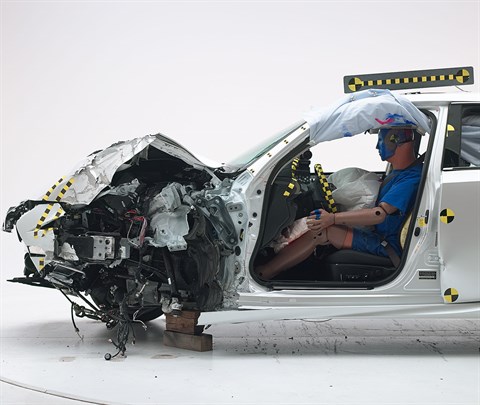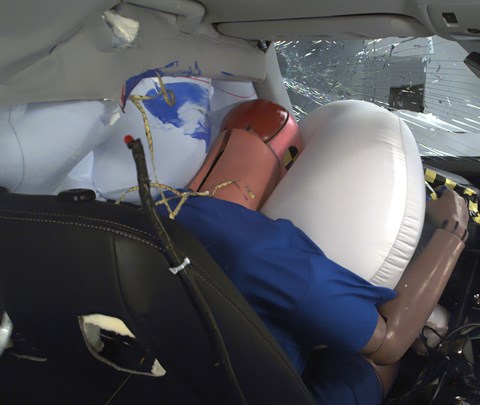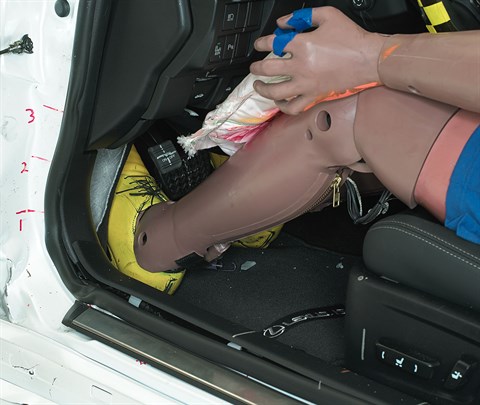Small overlap front: driver-side
Rating applies to 2017-25 models built after June 2017
Tested vehicle: 2017 Lexus IS 200t 4-door
The Lexus IS was redesigned for the 2014 model year. Beginning with the 2017 model year, the front-end structure was reinforced and the driver door, lower hinge pillar, and sill were modified to improve occupant protection in driver-side small overlap frontal crashes.
Beginning with 2017 models built after June 2017, the front-end structure was modified again and backing material in the footwell was added or changed to further improve occupant protection in driver-side small overlap crashes. (Information about when a specific vehicle was manufactured is on the certification label typically affixed to the car on the driver door or adjacent B-pillar.)
| Evaluation criteria | Rating |
|---|---|
| Structure and safety cage | |
| Driver injury measures | |
| Head/neck | |
| Chest | |
| Hip/thigh | |
| Lower leg/foot | |
| Driver restraints and dummy kinematics | |

Action shot taken during the small overlap frontal crash test of the 2017 Lexus IS built after June 2017.

The dummy's position in relation to the door frame, steering wheel, and instrument panel after the crash test indicates that the driver's survival space was maintained well.

The frontal and side curtain airbags worked well together to keep the head from coming close to any stiff structure or outside objects that could cause injury.

Forces on the left lower leg were just high enough to contribute to a moderate risk of injury.
Moderate overlap front: original test
Rating applies to 2014-25 models
Tested vehicle: 2014 Lexus IS 250 4-door
The Lexus IS was redesigned for the 2014 model year. Moderate overlap frontal ratings are assigned by the Institute based on a test conducted by Toyota.
| Evaluation criteria | Rating |
|---|---|
| Overall evaluation | |
| Structure and safety cage | |
| Driver injury measures | |
| Head/neck | |
| Chest | |
| Leg/foot, left | |
| Leg/foot, right | |
| Driver restraints and dummy kinematics | |
Side: original test
Rating applies to 2014-25 models
Tested vehicle: 2014 Lexus IS 250 4-door with standard front and rear head curtain airbags and standard front and rear seat-mounted torso airbags
The Lexus IS was redesigned for the 2014 model year. Side ratings are assigned by the Institute based on a test conducted by Toyota.
| Evaluation criteria | Rating |
|---|---|
| Overall evaluation | |
| Structure and safety cage | |
| Driver injury measures | |
| Head/neck | |
| Torso | |
| Pelvis/leg | |
| Driver head protection | |
| Rear passenger injury measures | |
| Head/neck | |
| Torso | |
| Pelvis/leg | |
| Rear passenger head protection | |
Roof strength
Rating applies to 2014-23 models
Tested vehicle: 2017 Lexus IS 300 4-door 4wd
(Curb weight from 2017 Lexus IS 200t 4-door 2wd)
| Overall evaluation | |
|---|---|
| Curb weight | 3,726 lbs |
| Peak force | 17,513 lbs |
| Strength-to-weight ratio | 4.70 |
Head restraints & seats
Seat type: Power leather seat
| Overall evaluation | |
|---|---|
| Dynamic rating | |
| Seat/head restraint geometry |
About the head restraint & seat test
Currently, IIHS tests apply only to front seats.
Headlights
Trim level(s)
- 300 trim
- 350 trim
| Evaluation criteria | Rating |
|---|---|
| Low-beam headlight type | LED projector |
| High-beam headlight type | LED projector |
| Curve-adaptive? | No |
| High-beam assist? | Yes |
|
Overall rating | |
| Distance at which headlights provide at least 5 lux illumination: | |
Low beams
On the straightaway, visibility was fair on the right side of the road and inadequate on the left side. On curves, visibility was fair on both right curves and inadequate on both left curves.
The low beams never exceeded glare limits.
High beams
On the straightaway, visibility was good on both sides of the road. On curves, visibility was fair on the gradual left and gradual right curves and inadequate on the sharp right and sharp left curves.
High-beam assist compensates for some limitations of this vehicle's low beams on the straightaway, on both left curves and on the gradual right curve.
Front crash prevention: vehicle-to-vehicle
Child seat anchors
Rating applies to 2017-25 models
| Evaluation criteria | Rating |
|---|---|
| Overall evaluation | |
| Vehicle trim | IS 300 |
| Seat type | leather |
This vehicle has 2 rear seating positions with complete child seat attachment (LATCH) hardware.
It has 1 additional seating position with a tether anchor only.
| Evaluation criteria | Rating |
|---|---|
| Overall evaluation | |
| Vehicle trim | IS 300 |
| Seat type | leather |
| Rating icon | Rating |
|---|---|
| G | Good |
| A | Acceptable |
| M | Marginal |
| P | Poor |
| Seating positions that rely on borrowed lower anchors or have only a tether anchor available are not rated. | |
thether anchor symbol | Tether anchor |
lower anchor symbol | Lower anchors |
| Lower anchor(s) can be borrowed from adjacent positions(s) | |
| No hardware available |
Details by seating position
| Position | Rating |
|---|---|
| 1 | |
| Tether anchor | |
| easy-to-find location | |
| no other hardware could be confused for anchor | |
| Lower anchors | |
| not too deep in seat | |
| not too much force needed to attach | |
| easy to maneuver around anchors | |
| 2 | |
| Tether anchor | |
| easy-to-find location | |
| no other hardware could be confused for anchor | |
| Lower anchors | |
| none available | |
| 3 | |
| Tether anchor | |
| easy-to-find location | |
| no other hardware could be confused for anchor | |
| Lower anchors | |
| not too deep in seat | |
| not too much force needed to attach | |
| easy to maneuver around anchors |
